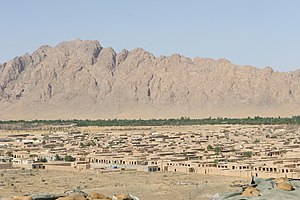Registan–North Pakistan sandy desert
| Registan–North Pakistan sandy desert | |
|---|---|
 | |
 Ecoregion territory (in purple) | |
| Ecology | |
| Realm | Palearctic |
| Biome | Deserts and xeric shrublands |
| Borders | |
| Geography | |
| Area | 277,916 km2 (107,304 sq mi) |
| Countries | |
| Coordinates | 39°15′N 63°15′E / 39.25°N 63.25°E |
| Conservation | |
| Protected | 1.44%[1] |
The Registan–North Pakistan sandy desert ecoregion (WWF ID: PA1326) covers the dry Sistan Basin of southern Afghanistan and portions of eastern Iran and southwest Pakistan. The Registan Desert is the eastern portion of the Sistan Basin.[2][3][1][4] The region is almost entirely dry sandy desert, with some irrigated cropland along the rivers. There are some seasonal wetlands at the western terminus of the Helmand River into Hamun Lake. The region support five endemic species of reptiles.
Location and description
The ecoregion basin is about 500 km (310 mi) across, surrounded by mountains. The
To the north are the Central Mountain ranges of Afghanistan, which are themselves the western extensions of the Hindu Kush Mountains. To the east are the Sulaiman Mountains of Pakistan, to the south the Central Makran Range in Pakistan, and to the west the Central Persian desert basins region. Across the middle run the granite Chagai Hills along the Afghan-Pakistan border.
Climate
The climate of the ecoregion is Cold desert climate (Köppen climate classification (BWk)). This climate features hot desert conditions in the summer, but cooler than hot deserts. Winters are cold and dry. At least one month averages below 0 °C (32 °F).[5][6]
Flora and fauna
The basin is one of the driest regions on earth; 95% of the territory is bare or sparse vegetation.[1] 4% of the land is cultivated, being irrigated on fertile land along the main rivers - the Helmand River, the Farah River, and the Khash River.[7]
Species richness is fairly high for a desert, with 391 species of vertebrates. But the only endemic species are a small number of reptiles: the Afghan toadhead agama (
Protected areas
Less than 2% of the ecoregion is officially protected.[1] These protected areas include:
- Hamun Lake
- Ras Koh Wildlife Sanctuary
References
- ^ a b c d e "Registan-North Pakistan sandy desert". Digital Observatory for Protected Areas. Retrieved August 1, 2020.
- ^ "Registan-North Pakistan sandy desert". World Wildlife Federation. Retrieved March 21, 2020.
- ^ "Map of Ecoregions 2017". Resolve, using WWF data. Retrieved September 14, 2019.
- ^ a b "Registan-North Pakistan sandy desert". The Encyclopedia of Earth. Retrieved August 28, 2020.
- ^ Kottek, M.; Grieser, J.; Beck, C.; Rudolf, B.; Rubel, F. (2006). "World Map of Koppen-Geiger Climate Classification Updated" (PDF). Gebrüder Borntraeger 2006. Retrieved September 14, 2019.
- ^ "Dataset - Koppen climate classifications". World Bank. Retrieved September 14, 2019.
- ^ "National Biodiversity Strategy & Action Plan" (PDF) (pdf). Islamic Republic of Afghanistan. Retrieved October 18, 2020.
